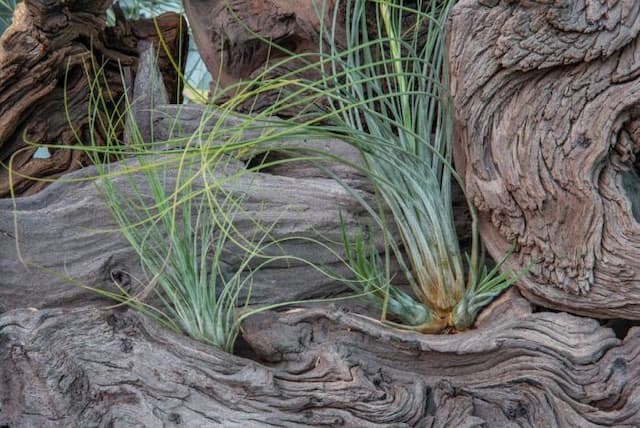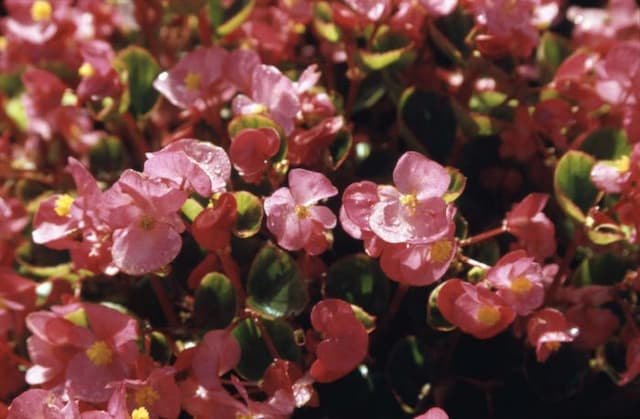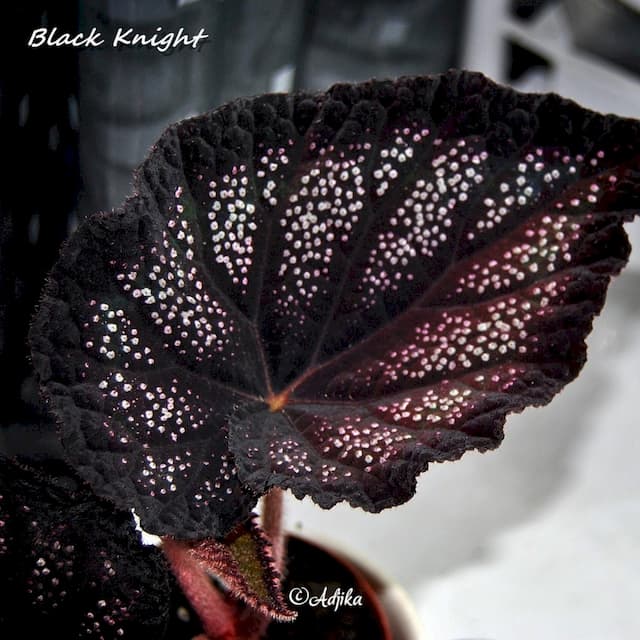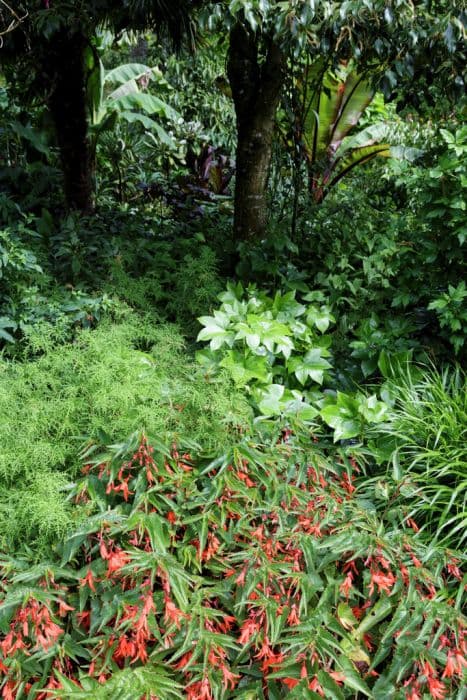Lima Love Begonia Begonia Lima Love = 'Krbelle01' (PBR) (Beleaf Series)

ABOUT
The Begonia Lima Love = 'Krbelle01' (PBR) from the Beleaf Series is a captivating plant known for its ornamental foliage and overall beauty. The leaves are the most striking feature, showcasing an array of colors that can include shades of green mixed with hints of red or pink, which may vary among individual plants. This visual variety is marked by dramatic contrasts and intricate patterns. The foliage often has a lush, velvet-like texture that adds to its tactile appeal. Edges of the leaves can be delicately ruffled or wavy, contributing to the plant's unique charm. During its blooming period, it produces clusters of subtle, inconspicuous flowers that may complement or contrast with the foliage, depending on the plant. However, it is the foliage that often steals the show, making this Begonia a popular choice for indoor decoration and in shaded garden areas where its leaves can be truly appreciated. The plant typically maintains a compact shape, which makes it a suitable and attractive option for pots, containers, or as part of a mixed plant display.
About this plant
 Names
NamesFamily
Begoniaceae
Synonyms
Beleaf Lima Love, Lima Love Begonia
Common names
Begonia Lima Love 'Krbelle01' PBR (Beleaf Series).
 Toxicity
ToxicityTo humans
Begonias, including the Begonia Lima Love, contain insoluble oxalates which can be mildly toxic to humans if ingested. Chewing or biting into this plant will release these crystals causing tissue penetration & irritation to the mouth & GI tract. Symptoms of poisoning may include a burning sensation in the mouth, lips, and tongue, excessive drooling, difficulty swallowing, and vomiting.
To pets
Begonias, such as the Begonia Lima Love, are also toxic to pets due to the insoluble oxalates they contain. If pets ingest any part of the plant, they might experience symptoms like oral irritation, excessive drooling, vomiting, and difficulty in swallowing. In severe cases, ingestion can result in kidney failure in animals like cats and dogs.
 Characteristics
CharacteristicsLife cycle
Perennials
Foliage type
Evergreen
Color of leaves
Mixed
Flower color
Varies
Height
1 foot (30 cm)
Spread
1 foot (30 cm)
Plant type
Herb
Hardiness zones
10
Native area
Central America
Benefits
 General Benefits
General Benefits- Easy to Care For: The Begonia 'Lima Love' is low maintenance, making it suitable for gardeners of all skill levels.
- Attractive Foliage: It features striking, colorful leaves that can add aesthetic appeal to any indoor space.
- Compact Growth: Its compact size makes it perfect for smaller spaces or as a tabletop plant.
- Long Flowering Period: This variety can bloom for extended periods, providing long-lasting color and interest.
- Versatility: It can be grown indoors as a houseplant or outside in containers and hanging baskets during warmer months.
- Breeding Innovations: As part of the Beleaf Series, it represents advanced breeding for improved characteristics like leaf shape and color.
 Medical Properties
Medical PropertiesThis plant is not used for medical purposes.
 Air-purifying Qualities
Air-purifying QualitiesThis plant is not specifically known for air purifying qualities.
 Other Uses
Other Uses- Photography Subject: Due to its unique foliage, the Begonia is often used by photographers as a subject for macro photography and to enhance the composition of garden photography.
- Craft Projects: Leaves of the Begonia can be used in craft projects, such as leaf casting, where they are used to create concrete garden ornaments that capture their intricate patterns.
- Educational Tool: Horticulture teachers may use the Begonia as a live example to educate students about plant care, propagation techniques, and leaf morphology.
- Container Gardening: This plant is well-suited for container gardening which can be used to decorate balconies, patios, or indoor spaces.
- Floristry: The Begonia's striking leaves can be incorporated into floral arrangements for an exotic touch or used as a natural confetti at events.
- Color Inspiration: Designers and artists could utilize the palette of the Begonia for inspiration in their work, whether for interior design, textile patterns, or artwork.
- Feng Shui: In Feng Shui, placing a Begonia in certain areas of the home is believed to bring positive energy, harmony, and can be used as a personal growth symbol.
- Theme Gardens: Begonia can be used in theme gardens where the aim is to display plants with specific colors or leaf patterns.
- Table Decoration: A small Begonia plant can add a vibrant burst of color and life to table settings, especially during special dinners or occasions.
- Biological Indicator: Because of its sensitivity to environmental changes, Begonia might be used by hobbyists as an informal indicator of indoor environment conditions, such as humidity levels.
Interesting Facts
 Feng Shui
Feng ShuiThe Begonia is not used in Feng Shui practice.
 Zodiac Sign Compitability
Zodiac Sign CompitabilityThe Begonia is not used in astrology practice.
 Plant Symbolism
Plant Symbolism- Caution: Begonias often symbolize caution due to their delicate nature, which may reflect in the 'Lima Love' variety, reminding people to tread carefully in new situations.
- Harmony: The Begonia 'Lima Love' with its balanced foliage could be seen as a symbol of harmony, representing a tranquil and serene environment.
- Gratitude: Giving begonias like the 'Lima Love' variety is a way to express thanks or appreciation, making them a suitable gift to express gratitude.
- Uniqueness: The distinct pattern and colors of the 'Lima Love' begonia may symbolize individuality and the celebration of being unique.
 Water
WaterThe Beleaf Begonia should be watered thoroughly, allowing the top inch of soil to dry out between watering sessions. A good practice is to water this plant once every week, with slight adjustments depending on the humidity and temperature conditions. When watering, use room temperature water and aim to moisten the soil evenly without leaving the plant standing in water. For a medium-sized Beleaf Begonia, typically about 8-12 ounces of water per week will suffice, but always adjust based on the plant's response and environment.
 Light
LightBeleaf Begonias prefer bright, indirect light without exposure to harsh direct sunlight, which can scorch their leaves. The best spot for these plants would be near an east or north-facing window where they can receive plenty of light but are shielded from the intense rays of the afternoon sun. Avoid placing them in deep shade or overly gloomy areas, as this can lead to poor growth and leaf drop.
 Temperature
TemperatureThe ideal temperature range for a Beleaf Begonia is between 65°F and 75°F, making them well-suited for typical indoor environments. They can tolerate a minimum temperature of 60°F and should be kept away from cold drafts and sudden temperature fluctuations. Avoid exposing them to temperatures below 50°F, as this can be harmful to the plant.
 Pruning
PruningPruning Beleaf Begonias is mostly done to remove any dead or yellowing leaves and to promote bushier growth. It's best to prune these plants occasionally, especially when you notice any unhealthy foliage. The best time to prune is in the spring or early summer when the plant is actively growing. Use clean, sharp scissors or pruning shears to make precise cuts without damaging the healthy parts of the plant.
 Cleaning
CleaningAs needed
 Soil
SoilThe best soil mix for Begonia 'Lima Love' is a well-draining, airy mix, such as one part peat, one part pine bark, and one part perlite or coarse sand. A pH of 5.5 to 6.5 is ideal for this plant.
 Repotting
RepottingBegonia 'Lima Love' should be repotted every 1-2 years or when it becomes rootbound. It's best to repot in spring before the growing season.
 Humidity & Misting
Humidity & MistingBegonia 'Lima Love' thrives in high humidity levels, ideally between 50% and 70%. Avoid placing in dry environments or near heat sources that reduce humidity.
 Suitable locations
Suitable locationsIndoor
Place in bright, indirect light and maintain high humidity.
Outdoor
Shelter from direct sun, keep in warm, humid spot.
Hardiness zone
10-11 USDA
 Life cycle
Life cycleThe life cycle of the Begonia 'Lima Love' begins with seed germination, where the plant emerges as a small seedling. Next is the vegetative stage, where the plant grows leaves and stems but no flowers, focusing on accumulating the resources necessary for blooming. After the vegetative phase, the plant enters the flowering stage, characterized by the development of vibrant flowers amidst the foliage. Once pollinated, it may produce seeds, completing the sexual reproduction cycle. The plant is capable of vegetative reproduction as well, through leaf or stem cuttings which root and grow into new plants. As a perennial, Begonia 'Lima Love' can live for several years, with periods of active growth and dormancy correlating with the seasons, until it eventually senesces and dies.
 Propogation
PropogationPropogation time
Spring-Early Summer
The Begonia Lima Love, part of the Beleaf Series, is most commonly propagated through leaf cuttings. To propagate, choose a healthy, mature leaf and cut it into sections making sure each piece has at least one vein. Lay the leaf pieces on a moist potting mix, pressing them down slightly so they make good contact with the soil. Cover the container with plastic to keep humidity high and place it in a warm, bright area without direct sunlight. Roots and new plants will begin to grow from the veins in a few weeks. Once they are sufficiently developed, they can be carefully transplanted into individual pots to continue growing.






![Begonia [Allure]](/_next/image?url=https%3A%2F%2Fplants-admin.emdemapps.com%2Fimages%2Fplants%2F%2Fimages%2F604b5b9006ab9.png&w=640&q=75)


